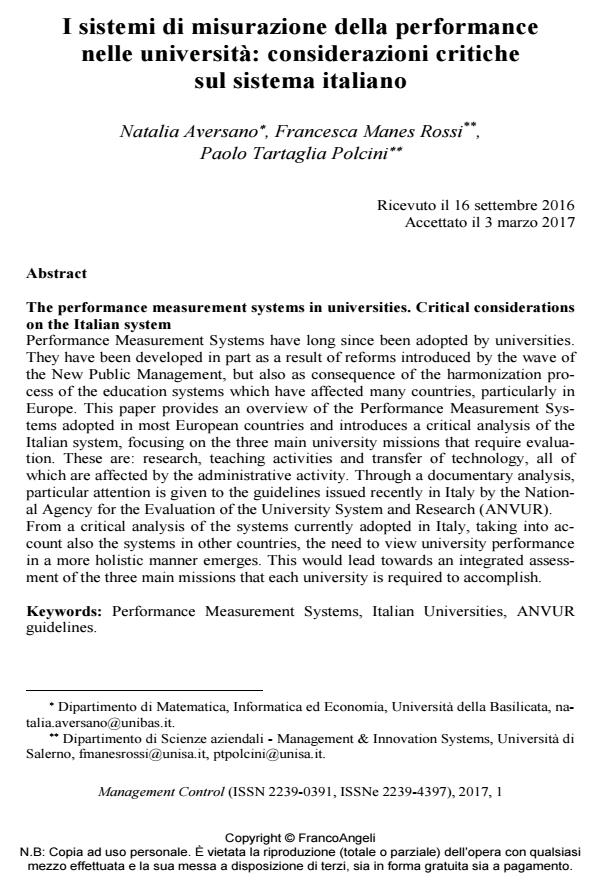I sistemi di misurazione della performance nelle università: considerazioni critiche sul sistema italiano
Titolo Rivista MANAGEMENT CONTROL
Autori/Curatori Natalia Aversano, Francesca Manes Rossi, Paolo Tartaglia Polcini
Anno di pubblicazione 2017 Fascicolo 2017/1
Lingua Italiano Numero pagine 22 P. 15-36 Dimensione file 458 KB
DOI 10.3280/MACO2017-001002
Il DOI è il codice a barre della proprietà intellettuale: per saperne di più
clicca qui
Qui sotto puoi vedere in anteprima la prima pagina di questo articolo.
Se questo articolo ti interessa, lo puoi acquistare (e scaricare in formato pdf) seguendo le facili indicazioni per acquistare il download credit. Acquista Download Credits per scaricare questo Articolo in formato PDF

FrancoAngeli è membro della Publishers International Linking Association, Inc (PILA)associazione indipendente e non profit per facilitare (attraverso i servizi tecnologici implementati da CrossRef.org) l’accesso degli studiosi ai contenuti digitali nelle pubblicazioni professionali e scientifiche
Performance Measurement Systems have long since been adopted by universities. They have been developed in part as a result of reforms introduced by the wave of the New Public Management, but also as consequence of the harmonization process of the education systems which have affected many countries, particularly in Europe. This paper provides an overview of the Performance Measurement Systems adopted in most European countries and introduces a critical analysis of the Italian system, focusing on the three main university missions that require evaluation. These are: research, teaching activities and transfer of technology, all of which are affected by the administrative activity. Through a documentary analysis, particular attention is given to the guidelines issued recently in Italy by the National Agency for the Evaluation of the University System and Research (ANVUR). From a critical analysis of the systems currently adopted in Italy, taking into account also the systems in other countries, the need to view university performance in a more holistic manner emerges. This would lead towards an integrated assessment of the three main missions that each university is required to accomplish.
Parole chiave:Performance Measurement Systems, Italian Universities, ANVUR guidelines
- Moving from Social and Sustainability Reporting to Integrated Reporting: Exploring the Potential of Italian Public-Funded Universities’ Reports Sara Giovanna Mauro, Lino Cinquini, Elena Simonini, Andrea Tenucci, in Sustainability /2020 pp.3172
DOI: 10.3390/su12083172 - Il ruolo dei manager universitari in un'ottica di performance integrata. Analisi di un caso studio Franco Rubino, Pina Puntillo, Stefania Veltri, in MANAGEMENT CONTROL 3/2017 pp.95
DOI: 10.3280/MACO2017-003007 - Legitimating efforts in Performance Plans. Evidences on the thoroughness of disclosure in the Italian Higher Education setting Alessandra Allini, Adele Caldarelli, Rosanna Spanò, Annamaria Zampella, in MANAGEMENT CONTROL 1/2019 pp.143
DOI: 10.3280/MACO2019-001007 - Il risk management approach nelle Università italiane: prime riflessioni su vincoli e opportunità Manuela Lucchese, Giuseppe Sannino, Paolo Tartaglia Polcini, in MANAGEMENT CONTROL 1/2020 pp.111
DOI: 10.3280/MACO2020-001006 - Integrating strategic planning and performance management in universities: a multiple case-study analysis Lucia Biondi, Salvatore Russo, in Journal of Management and Governance /2022 pp.417
DOI: 10.1007/s10997-022-09628-7 - Accounting Reform in Italian Universities. Internal Response to Accounting Change Marco Tieghi, Rebecca L. Orelli, Emanuele Padovani, in MANAGEMENT CONTROL 1/2018 pp.117
DOI: 10.3280/MACO2018-001006 - Il PIAO come strumento di cambiamento strategico: il caso dell'Università Vanvitelli Riccardo Macchioni, Francesca Manes Rossi, Carmela Luise, in MANAGEMENT CONTROL 3/2024 pp.135
DOI: 10.3280/MACO2024-003007 - Social Network e Stakeholder Engagement, un binomio tutto da sviluppare? Un confronto tra le università pubbliche di Italia e Cina Elena Gori, Silvia Fissi, Michele Fiumanò, in MANAGEMENT CONTROL 1/2018 pp.95
DOI: 10.3280/MACO2018-001005 - On intellectual capital management as an evaluation criterion for university managers: a case study Stefania Veltri, Pina Puntillo, in Journal of Management and Governance /2020 pp.135
DOI: 10.1007/s10997-019-09461-5 - Distorsioni nel sistema di accountability delle Università: analisi di un caso Andrea Francesconi, Enrico Guarini, Francesca Magli, in MANAGEMENT CONTROL 1/2020 pp.59
DOI: 10.3280/MACO2020-001004
Natalia Aversano, Francesca Manes Rossi, Paolo Tartaglia Polcini, I sistemi di misurazione della performance nelle università: considerazioni critiche sul sistema italiano in "MANAGEMENT CONTROL" 1/2017, pp 15-36, DOI: 10.3280/MACO2017-001002